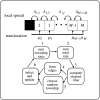Spatial dynamics and genetics of infectious diseases on heterogeneous landscapes
- PMID: 17490941
- PMCID: PMC2074889
- DOI: 10.1098/rsif.2007.1041
Spatial dynamics and genetics of infectious diseases on heterogeneous landscapes
Abstract
Explicit spatial analysis of infectious disease processes recognizes that host-pathogen interactions occur in specific locations at specific times and that often the nature, direction, intensity and outcome of these interactions depend upon the particular location and identity of both host and pathogen. Spatial context and geographical landscape contribute to the probability of initial disease establishment, direction and velocity of disease spread, the genetic organization of resistance and susceptibility, and the design of appropriate control and management strategies. In this paper, we review the manner in which the physical organization of the landscape has been shown to influence the population dynamics and spatial genetic structure of host-pathogen interactions, and how we might incorporate landscape architecture into spatially explicit population models of the infectious disease process to increase our ability to predict patterns of disease occurrence and optimally design vaccination and control policies.
Figures









References
-
- Asano, E., Gross, L. J., Lenhart, S. & Real, A. L. In press. Optimal control of vaccine distribution in a rabies metapopulation model. Math. Biosci. Eng. 1. - PubMed
-
- Avise J.C. Harvard University Press; Cambridge, MA: 2000. Phylogeography: the history and formation of species.
Publication types
MeSH terms
Grants and funding
LinkOut - more resources
Full Text Sources
Medical

